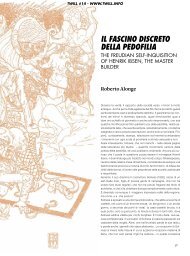AT WORK IN THE FIELDS OF THE BOMB - Twill
AT WORK IN THE FIELDS OF THE BOMB - Twill
AT WORK IN THE FIELDS OF THE BOMB - Twill
You also want an ePaper? Increase the reach of your titles
YUMPU automatically turns print PDFs into web optimized ePapers that Google loves.
Model of<br />
the Uranium Atom<br />
Uranium is one of the heaviest naturally occurring<br />
elements on earth. It can be used in nuclear<br />
weapons or it can become the base from which<br />
plutonium, a more powerful nuclear explosive, is<br />
made. Uranium is unstable; when a single uranium<br />
atom breaks apart it releases, on average,<br />
two neutrons, one of which can smash into other<br />
uranium atoms and split them apart, releasing<br />
large amounts of energy - and two more neutrons.<br />
It is this geometric progression that makes<br />
a runaway chain reaction explosion possible.<br />
Uranium has a half-life of 4,468,000,000<br />
years, which means that after that much time has<br />
elapsed, half of a given amount of uranium will<br />
have spontaneously decayed into other elements.<br />
Each one of these subsequent elements has its<br />
own half-life.<br />
The Uranium-238 Decay Chain<br />
Product in Kind of<br />
decay chain radiation Half-life<br />
Uranium-238 alpha 4,468,000,000 years<br />
Thorium-234 beta 24.1 days<br />
Protactinium-234m beta, gamma 1.17 minutes<br />
Uranium-234 alpha 245,000 years<br />
Thorium-230 alpha 80,000 years<br />
Radium-226 alpha 1,602 years<br />
Radon-222 alpha 3.823 days<br />
Polonium-218 alpha 3.05 minutes<br />
Lead-214 beta 26.8 minutes<br />
Bismuth-214 beta 19.7 minutes<br />
Polonium-214 alpha .000164 seconds<br />
Lead-210 beta 22.3 years<br />
Bismuth-210 beta 5.01 days<br />
Polonium-210 alpha 138.4 days<br />
Lead-206 (stable) non-radioactive<br />
20<br />
Interviews<br />
and<br />
Field Notes<br />
The Amount of Plutonium in the<br />
Nagasaki Bomb<br />
The sphere of plutonium-239 in the Nagasaki<br />
bomb weighed 6,100 grams. One gram of plutonium,<br />
or one-third the weight of a penny, transformed<br />
its mass into pure energy to produce the<br />
explosion that destroyed Nagasaki’s Urakami<br />
val ley. The glass ball in the photograph is held by<br />
Richard Rhodes, author of The Making of the<br />
Atomic Bomb.<br />
Howard Morland’s Model of a<br />
Modern H-bomb Warhead<br />
The modern thermonuclear warhead is termed a<br />
“physics package”. This is the explosive fissionand-fusion<br />
core of a hy drogen bomb. A warhead<br />
this size would weigh about 270 pounds. Howard<br />
Morland was the first to make visible to the<br />
public the inner workings of the H-bomb. He<br />
pieced together its physics and internal design<br />
from unclassified literature and conversations with<br />
industry and govern ment officials. In 1979 the U.S.<br />
govern ment sued to prevent the publication of his<br />
article “The H-bomb Secret (To Know How Is to<br />
Ask Why)” in The Progressive. Morland welcomed<br />
the lawsuit, maintain ing that there are no longer<br />
any scientific secrets about H-bomb design. In court<br />
he demonstrated the public nature of his data, won<br />
the case, and published his article.<br />
Howard Morland<br />
Washington, D.C., January 12, 1984<br />
~ Howard, before most people were in volved in<br />
thinking about weapons, you pieced together how a<br />
thermonuclear bomb works and you made a model<br />
of its insides for all to see. How long did it take<br />
you to do that and what is it that you discovered<br />
along the way?<br />
- Well, it took six months to discover the H-bomb<br />
secret. One of the first places I looked when I began<br />
my research into thermonuclear devices was the<br />
Encyclope dia Americana, which is on public<br />
library shelves all over the country. In it was a very<br />
strange diagram - it showed a ther monuclear device<br />
with an atomic bomb inside one end of it, and a<br />
blob of something, lithium-6 deuteride, inside the<br />
other end. Other encyclopedias that I looked at<br />
had diagrams of H-bombs too, but this was the<br />
only one that had the stages separated, and it turns<br />
out that this “separation of stages” was the correct<br />
design concept. So in that one picture in one<br />
encyclopedia I found the essence of the H-bomb<br />
secret.<br />
~ And what is that secret?<br />
- Well, the federal government, when it tried to stop<br />
the publication of my article in The Progressive -<br />
and succeeded in doing so for six months - said<br />
that there were three elements to the H-bomb<br />
secret that I had revealed in my manuscript. The<br />
first element was the separation of stages - the fact<br />
that within the overall casing, the atomic bomb is<br />
physically separate from the hydrogen bomb.<br />
The second element was compression of the<br />
hydrogen fuel, which basically means that if you<br />
pack any kind of material together closely, reactions<br />
will take place within it more quickly. The third<br />
element, and this was the real secret, was called<br />
“radiation coupling” - the use of electromagnetic<br />
radiation produced by the exploding atomic bomb to<br />
ignite, or trigger, the nearby hydrogen component.<br />
These three design concepts were implicit in<br />
that Encyclopedia Americana diagram. But I had<br />
to do a lot of digging to realize what the diagram<br />
meant.



